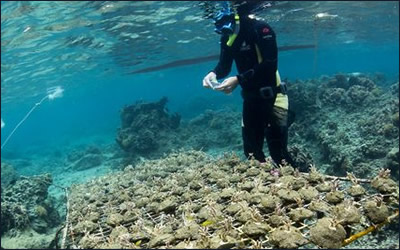Brian Handwerk
for National Geographic News
Published October 17, 2011
Warming oceans, coastal pollution, and even sunscreen have been blamed for the perilous state of the world's coral reefs. (See "Giant Coral
Die-Off Found—Gulf Spill 'Smoking Gun?'")
Now scientists have added another coral-killing culprit to the mix: seaweed.
A new study of reefs around the Fiji Islands found that some seaweed causes coral bleaching and suppresses photosynthesis by emitting anti-coral
chemicals.
Such seaweed could be helping to curb coral growth on reefs worldwide, the study authors say.
During the last several decades, scientists have observed numerous coral reefs being conquered by seaweeds. But experts haven't been sure if the
algae contributed to coral decline or simply benefited from it.
"Now our research suggests that, once corals decline due to a combination of global and local stresses, some seaweeds use chemical warfare to
suppress the recovery of remnant adult corals and new coral recruits," said study co-author Douglas Rasher, a doctoral candidate at the Georgia
Institute of Technology in Atlanta.
(Related: "Seaweed Found in Fiji May Help Fight Cancer, AIDS.")
Killer Seaweed Aided by Overfishing, Runoff
It's unlikely that seaweed developed chemical weapons specifically to attack coral, since interactions between the two organisms have been
historically infrequent on pristine reefs, Rasher said.
"We hypothesize that [seaweeds] may have evolved to produce these compounds on their surfaces in response to competition with microbes or
attacks from [grazing animals], which they've been fighting for millions of years," he explained.
"It's only in ecologically recent times—perhaps over the last 30 or 40 years—that seaweeds have begun to have an impact on corals."
Two main forces are thought to be driving the seaweed boom on reefs. In some cases, agricultural and sewage runoff dumps large amounts of
nutrients on near-shore reefs, stimulating algae growth.
(Related: "'Super Suckers' Slurp Invasive Algae off Reefs.")
In other cases, including at Rasher's study site in Fiji, seaweed may be gaining a foothold due to overfishing of algae-eating species.
For instance, near each coastal village Rasher studied there's a marine protected area, with no fishing allowed, right next to unprotected reefs that
are open to fishing.
"You often see the unprotected reefs dominated by macroalgae [i.e., seaweed], with corals and fish biomass being suppressed," he said.
"This seems to be a consistent pattern along the coasts where we're working, so you can see the [juxtaposition] even at a local scale, within a few
kilometers."
Algae-Eaters Needed to Protect Reefs
Rasher and his advisor, Mark Hay, hope their research can help reef managers understand which algae are harmful to coral and highlight ways to
reverse the trend of seaweed growth.
"For years we have seen patterns suggesting that seaweeds might be chemically damaging corals," Hay said.
"Doug's work finally demonstrates that it is chemical, [reveals] what those chemicals are, and [shows] which fishes best control the most
chemically aggressive seaweeds."
(Related: "Human Feces Bacteria Jumped to Coral, Caused Die-off.")
Rasher added that Fiji's protected marine reserves could naturally supply new coral larvae to adjacent reef habitats, although the situation is
unlikely to improve if seaweeds continue to suppress new coral recruits.
"Our results suggest that bans on the harvest of seaweed-eating fish may decrease algal abundance on the degraded reefs and thus make these
reefs more prone to coral re-establishment," he said.
The seaweed-and-coral study is published in the October 17 issue of the Proceedings of the National Academy of Sciences. |

